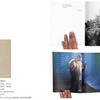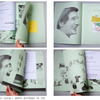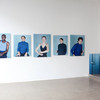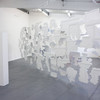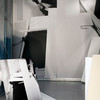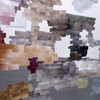A Conversation with Anouk Kruithof

Anouk Kruithof is one of the recipients of this year’s ICP Infinity Awards. Over the past few years, she has produced a string of cutting-edge books, many of them self-published. So there were many reasons why I wanted to talk to her about her work. (more)
Jörg Colberg: I have two topics I wanted to talk to you about. The first one concerns photobooks. What role do photobooks play for you in your practice?
Anouk Kruithof: My books are works on itself. For me a good artistbook requires two elements: it has to contain a strong piece of work, and the final physical form should reinforce the content of the book. The correct melting process gives the book the rights to be a work on its own existence. The form of a book I consider as a scope to show my work in, just like an art space can be a scope or maybe even the little screen on an iPhone.
Let’s take Happy Birthday To You as an example to explain a bit more about my ideas concerning bookmaking. First, I did all these birthday celebrations. The activities were of course real and photography was used to document the events. The photographs inherit the memories. I think in such a case a book really is a good form to tell a story and to show what happened during these birthday celebrations to a broader public.
It’s not that the photos become the art work in this case: I really see the book as an art work. I like that you don’t need to show those photographs on the wall, because this project is quite an intimate collaboration between me, my intern and the patients who had their birthdays.
There is a parallel in how I use the medium photography and the book. Both deal with a fixed frame, like a photograph itself as a result of what you frame. A book is a bit like that, you know. It always has pages, it has a beginning and an end.
I love to work within these frames but at the same time I want to escape from them. That’s why I make those more tactile, physical objects where there are pages of different sizes, or they are fold-out pages that come out of the frame of the book. I think in my own photography I also do that.
JC: It seems as if you’re almost constantly frustrated with the limitations of the medium photography or the book. You’re always trying to break out and do something about it.
AK: Yes. That’s true. But it’s weird; I mean I don’t feel frustrated… Well, with photography I do maybe? because sometimes I really hate it. And at other times I really love it.
To make good work I need some resistance. Also, when you start making books you dig deeper and try to find out what a book is. You have to look at old books; you have to think about them, why are books often made in certain ways. I really need to experiment a lot when I start to make a book. What I really like is that when you play a lot then things appear that you didn’t knew before and you learn from it. The very moment when things appear in of your hands, uncontrolled or even unconscious - that is the moment when things starts to become interesting for me. This is maybe even the essence of creating for me. It brings looseness and air, and you can find this aspect in my photographs, in my videos, in my installations, and you can also find this in my books. I can see that actually in all my work.
JC: It’s interesting that you say that because a lot of photographers like to have a lot of control over their process so they can focus on the image making. With you it seems like you’re doing it the other way around. You want to give up control so that you can find something.
AK: Yes. I think it’s maybe a true what you say. I work the other way around.
For example, when you make a sculpture with a material like clay it obviously can be very likely that you don’t know what’s going to happen when you work on it. Making photos and using a camera is more controlled, because of the use of a camera. It’s quite fixed. You capture an image by framing a part of reality, whatever this might be.
I make photos, many photos. Maybe too many photos? But I work with my own photos as material. The first state is to make photos, and after that I treat them as my material. It’s often not the case that a photograph is the end result or is my work. It sometimes might be, but not very often. For example when I don’t like a part of a photo I just cut it out. For me, that’s not disrespectful because I want to make a work, and I have no restrictions or conventions I have to deal with. So when something bothers me in a photo I just remove it, and then I rephotograph it.
JC: That leads me to something else I was going to ask you. Actually, there are two aspects, let’s start maybe with one, the idea of installation. I’ve seen some of your installations. You’re presenting your photographs, but you’re not really doing that. You’re more or less building something that contains photographs and that works with a space. Could you talk about that a little?
AK: Yes. Maybe it’s a good idea to talk about the emergency exit from ‘Het Nederlands Fotomuseum’ in Rotterdam, where I made my photo installation ‘Intercollapsing’ as an example. The curator asked me if I wanted to make a site-specific installation for this emergency exit, which is something like a forgotten glass-space that leads from inside the museum to the outside. When there is an emergency people open the door, and they have to pass through that space. It was really challenging for me when they asked me to work with that space. I had to look at the architecture of the building and think about the meaning of an emergency exit. Things came together for me when I thought about these two aspects.
The project I showed in this exhibition entitled ‘Quickscan #1’ was ‘Playing Borders, this contemporary state of mind’. It consisted out of images I made in an abandoned office building, which were like doomsday scenarios for our bursting society. There’s a photo which I call Office Shelter #1. It is a photo of a temporary installation made out of ceiling panels.
On other photos this ‘Office Shelter is collapsing by the force of a man struggling with this Office Shelter #1. This causes the installation to get instable, and it finally collapses in a very playful way. This process or ‘1 to 1 performance’ itself is photographed. My photos are the frozen moments from a dynamic action process. Exactly this aspect of photography, where you stop time in between moments by taking a photo - that is what I do love about photography. This is visible in many of my photographs.
For the installation in the emergency exit I decided to work against the architecture. There’s this doomsday scenario happening in the images, and if there were a real emergency this would relate to what you see on the photos. I mounted some photos on dibond and made a wallpaper, and I stabilized the photos standing on the floor with ceiling panels - the actual ceiling panels I took from the office building where I worked in before. They are exactly the same ceiling panels as you see in the photos. It is a formal and at the same time informal play with the architecture, talking about instability - which relates in some ways to the meaning of the emergency exit to me. When you looked at the installation from the outside, from the street, you only saw the white backgrounds of the photos and ceiling panels. The whole space looked very unstable - all those diagonals work against the architecture of the building. You almost got the feeling the museum itself was about to collapse.
This is what people told me and I really like that, it raised questions. In cases like this I get very enthusiastic to think about a space, and I see the space as a scope to make work in. When I talk with photographer friends that’s a topic where we sometimes don’t connect at all. They really don’t understand what I’m talking about.
JMC: I can imagine. If you go to a gallery show of photography it’s always this big box, with nothing in the center and everything on the walls. You walk through, and that’s photography for most people. For you, it’s different. It seems as if just like you want to make a book work you also want to make a space work, so that the photographs make sense in the space.
AK: Exactly. There is the studio and you make some work. And then there is the moment you bring it outside of your studio. It becomes art. Once you make this step whatever the platform is where you present your work outside your studio: you have to think of why you do it this way or that way. And of course not worry too much about the consequences. :-)
I do like to change the space as well. In my most recent solo exhibition in the young gallery BoetzelaerINispen in London I did that. I made an installation (10 mtr long by 3 mtr high) out of my old photographs (from 1999/2000 till 2008). I literally cut up my archive: I cut out the narrative of the originally self-printed analogue colour photos, and I transformed them into abstract pieces of coloured old photo paper. It was very intense to do that: I had started with it during my stay in Küstlerhaus Bethanien in Berlin in April 2008. But after a while I couldn’t do it anymore. Later, in spring 2010, I continued working on it with my two interns. In the beginning of 2012, there was the final installation ‘Wall of fading memory’. This is a very specific project for me, and it is important for me. It’s about dissecting the medium photography as well as the struggle, which is ingrained in memories. I like to invent new things out of fragments of the past - if that’s possible.
JMC: Something else I was going to talk to you is the idea of performance, in particular intervention. You actually just said it, you’re a very playful person, but you always want to mess things up a little bit, in an artistic sense. For example, in Becoming Blue you do something so your sitters get a certain reaction. Or take the case of your photo cakes: There’s a photograph, but you actually eat it. So you destroy it - while you enjoy it. Maybe this is just my own reading, but I see this in your work, this enjoyment through destruction.
AK: That’s a really hard question. I see that aspect too: Destruction…It scares me a bit, it always sounds so hard and brutal, which I think it isn’t really. There is a romantic side to destruction as well as a funny one. With the photocakes you cut through an image, by means you destroy the image, but on the other hand, you get pleasure from eating it as well as the transformation process of the photo while cutting and eating it. New (uncontrolled) images appear when cutting and dividing the cake. The beauty is the fact that everybody takes part of the artistic process and what happens is out of my control: yeah! It is very social what I like about it. To feed people with art and let them take part of it. It connects people because eating is a basic element.
This is related to my ‘take away’ works. When you bring home one of my posters or you put one page out of The Daily Exhaustion on your wall, you get involved because you can play with it yourself like I do that in my process of making my work. That’s is one reason why I like to make lots of piles of posters, postcards or zines to take away for free.
JMC: So for you it’s really more about having the viewer not just be a passive viewer, the viewer always has to do something. With a book s/he has to unfold things, s/he has to work with the book. In an exhibition s/he has to cut the cake or has to move through your space. There always is something else beyond just looking.
AK: You’re right. Most of the time I try to let the viewer experience something, not only in a mental way but also in a psychical way. It’s not like a real activity and I don’t think of it as entertaining. But I like the fact that you involve the viewer: activate people. I just think that’s beautiful when the viewer becomes a part of what I do with my work.
JMC: It seems like there are many metaphors in your work. Can you talk about that a little bit? Let’s say walls. What for example does a wall mean for you?
AK: Yes, I use metaphors in my work. And yes, I like the meaning of a wall, because it has so many contradictions in itself. In the basic sense they are walls of a building, the construction around us that ensures that we’re safe. But on the other hand a wall can also be a border you can’t cross - the opposite of being safe. I also like the metaphorical aspect that people have a wall around them. You build your personality or you decide how you show yourself in public. But actually what’s behind that wall, what’s inside of people’s heads and souls - that is interesting to me. You don’t see that coming out so often, but I am really interested in that.
Mentally ill people don’t (unfortunately or fortunately?) have this, let’s call it ‘social boundary’, whereas most people always want to show themselves in a suitable way. It seems to me that especially business people create an image of themselves with a very thought out idea behind it. You might have to behave and dress up like this or that, because it’s a strategy with a bunch of unwritten rules. This fascinates me as well.
Working on the Happy birthday to you project for a period of three months mentally ill people surrounded me. To hang out with them became my life, because I lived by myself in a huge villa at the edge of a forest, my house and studio, isolated from lively Holland. Of course it’s very sad that those people are very ill in their minds. But what fascinates me is that because of this illness they have no limitations. They seem to be completely free, although they are locked up in their heads. And sometimes because of this they are literally locked up as well between ‘walls’ (= the closed department). What a tough contradiction it is… But the beauty lies in the fact that everything they say or do is straight from the heart. And it’s very unexpected. All of a sudden they might run away.
In our Western society where everything is organized, the way we human beings function gets pretty boring. We are almost becoming robots, doing the same things over and over again.
I sometimes think (actually because Penelope Umbrico pointed that out to me) that when I collaborate with strangers in my photos I kind of search for ‘this mental gap’. In my performative works, when strangers are involved, I try to get that aspect out of them, because I know everybody has that side in her or himself. It is all a matter of hiding it.
I think you can find this quirkiness in my photographs where people are present. I liked a lot how Christoph Tannert described this in an essay about my work:
“It seems as if these figures were anchored a little outside our world, at the boundary between frightening monstrosity and what is determinable, as if a turbine of fate were constantly blowing them back and forth between solid ground and the abyss.”
My grandma lived on the closed department of a mental institution, and I used to visit her every Sunday when I was young. So I grew up with mental illness and I’m very familiar with it. For a long time my sister worked in the closed department of an institution for mentally ill teenagers as well. I think because of the experience I had in this field I was able do the birthday project. It was pretty tough actually. Many people are terribly afraid of how mentally ill people behave, because you don’t know what to expect, and most people like to be in control. Occasionally, I was also afraid. But often it made me laugh that during the whole time something unexpected might happen. You just never, never know what beforehand. In some ways that’s similar to the process of making my work. You can’t control it. And that’s great about it!
 By
By 

